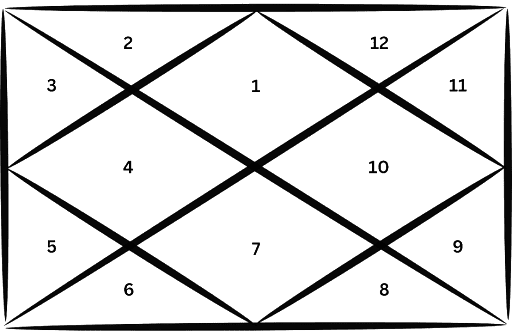
Your destiny lies written in the stars, but decoding the secrets of your Vedic astrology chart can be confusing. With so many planets and houses to consider, making sense of it all can be quite overwhelming. If you’ve ever wanted to unravel the mysteries of your fate and life’s purpose with your Vedic birth chart, you may feel overwhelmed with where to even begin.
As an astrologer, I know firsthand how complex these ancient charts can appear. But having the right tools makes all the difference. With this easy, step-by-step guide, I will show you how to unlock your destiny by reading your Vedic astrology chart. You’ll even learn how to connect the dots between different astrological aspects and make accurate predictions.
That said, it can get confusing when you try to put it all together. In those cases, having a session with a Vedic astrologer can provide clarity and guidance. Keen has a great variety of Vedic astrologers that can bring you clarity. These professionals can help you with the ins and outs of understanding Vedic astrology.
Quick Overview: 5 Steps To Read Your Vedic Astrology Chart
- Find the important houses: The 12 houses reveal information about different life areas from careers to relationships. Learn the significance of each house.
- Identify where all 9 planets are located: Planetary placements indicate core personality attributes and influences. See how to interpret planet positions.
- Locate your planetary signs: Your planets fall into different zodiac signs, shaping motivations and desires. Check out what each sign means for individual planets.
- Discover your Ascendant: Your rising sign offers clues into outward personality and approach to life. Figure out what your Ascendant says about you.
- Identify important aspects: Specific angular relationships between planets highlight gifts, issues, and lessons. See what key aspects signal for growth opportunities.
What Is a Vedic Astrology Chart?
Vedic astrology, known as Jyotisha in Sanskrit, has its roots in ancient Vedic scriptures of India. A Vedic astrology chart, also called a vedic kundli or janam kundali, maps out positions and alignments of celestial bodies including planets, signs, and stars at the precise time and place of birth.
This astronomical snapshot provides the basis for analyzing destiny, fate, and character. The specific angles formed between planets as well as the placement in zodiac signs and houses reveal information about core personality, relationships, optimal career paths, luck, karmic lessons, and key events expected throughout the course of your lifetime.
The tools used within Vedic astrology include the Sidereal Zodiac, aligning with the constellations, and the Lahiri Ayanamsa calendar system charting planetary movements. Through Vedic calculation methods and astrological symbol interpretation, your Vedic birth chart illuminates multidimensional insights into your life.
How to Create a Vedic Astrology Chart
Vedic astrologers today rely on specialized software to accurately generate detailed birth charts swiftly. This enables efficient analysis based on precise planetary positions. Here is how you can make use of vedic astrology software to calculate your chart:
- Choosing the Software: Popular Vedic astrology software options include Goravani Jyotish, Parashara’s Light, JHora, and Astro-Vision LifeSign Mini. Each platform has different features but the core ability to produce accurate charts.
- Entering Birth Details: The first step is entering the exact native birth details, which is the date, time and location, into the software. Some programs allow searching locations by city and map coordinates.
- Configuring Settings: Next, you configure relevant settings like zodiac system (Sidereal), house system (Placidus), Ayanamsa value (Lahiri), and any other parameters to align with Vedic principles.
- Generating Charts: Once accurate birth data is entered and optimal settings selected, you generate and print the detailed rashi birth chart, navamsa chart, aspect analysis plus any divisional charts.
- Interpreting the Output: Finally, the software output with precise planetary positions, ascendant, and house placements is carefully analyzed using Vedic interpretive principles to offer life guidance.
5 Steps To Read Your Vedic Astrology Chart
1. Find The Important Houses

The 12 houses in a Vedic birth chart provide information across all life domains, falling into groupings called triplicities. Locating house placements in the natal chart reveals destined experiences in those domains.
Also, identifying the ruling planet of houses and the signs occupying them adds further nuance. Ultimately, interpreting interconnections amongst the houses creates a synthesized map of life’s possibilities.
The houses in a Vedic birth chart are categorized into four vital life pursuits:
- Dharma houses (1, 5, 9) govern righteous duty and wisdom.
- Artha houses (2, 6, 10) rule career, reputation and prosperity.
- Kama houses (3, 7, 11) relate to relationships and desires.
- Moksha houses (4, 8, 12) represent spirituality and transcendence.
Additionally, there are three sub-classifications:
- Kendra houses (1, 4, 7, 10) provide stability as angular houses.
- Trinal houses (1, 5, 9) are considered auspicious as they promote connectedness.
- Dusthana houses (6, 8, 12) tend to indicate more challenges.
Here is the meaning, life pursuit and sub classification for each house:
- The 1st house: Represents identity and self. It is a Dharma, Kendra, and Trinal house.
- The 2nd house: Signifies wealth, speech, and family assets. It is an Artha house.
- The 3rd house: Relates to willpower, skills, siblings, and bravery. As a Kama house, it covers interpersonal efforts.
- The 4th house: As a Moksha and Kendra house, it covers home, domestic happiness, and emotional foundations.
- The 5th house: A Dharma and Trinal house that governs romance, children, investments, and creative pursuits.
- The 6th house: Signifies debts, diseases, adversaries, and service. As a Dusthana house, it indicates challenges.
- The 7th house: As a Kama and Kendra house, the 7th house relates to marriage, partnerships, and business relationships.
- The 8th house: A Dusthana and Moksha house that signifies transformations, longevity, and mysteries of life.
- The 9th house: Being a Dharma and Trinal house, the 9th house governs luck, divine grace, spirituality, and destiny.
- The 10th house: Covers career, public status, and legacy building as an Artha and Kendra house.
- The 11th house: As a Kama house, the 11th house relates to social networks, profit goals, and communities.
- The 12th house: This house relinquishes attachment through expenses, losses, isolation, and self-undoing. The 12th house is a Moksha and Dusthana house.
2. Identify Where All 9 Planets are Located
The 9 grahas/planets in Vedic astrology significantly shape personality, life path, and destiny based on their natal placements and combinations. The house, sign, and planetary aspects determine if a graha expresses more beneficially or malefically.
Each house in the birth chart is ruled by the planet that owns the zodiac sign occupying the house cusp. For example, if Aries, ruled by Mars, falls on the cusp of the 2nd house, Mars becomes the lord of the 2nd house.
Key positive planets include Jupiter and Venus while Mars and Saturn tend toward being malefic. The natal Moon reveals emotional needs. The Sun signifies confidence and leadership style. Most pivotally, the 1st lord shapes self and vitality, the 9th relates to purpose and fortune, and the 10th governs career and legacy.
Analyzing planetary combinations thus provides the map to fulfilling your maximum potential. In vedic astrology, only planets that come before Saturn are used. Neptune, Uranus, Pluto, and asteroids are not traditionally included in Vedic astrology.
Planet |
Symbol |
Abbreviation |
Attributes & Areas of Governance |
| Sun | ☉ | Su | Soul, ego, vitality, leadership |
| Moon | ☽ | Mo | Emotion, mind, happiness, mother |
| Mars | ♂ | Ma | Energy, courage, aggression, conflicts |
| Mercury | ☿ | Me | Intellect, communication, skill aptitude |
| Jupiter | ♃ | Ju | Wisdom, prosperity, generosity, principles |
| Venus | ♀ | Ve | Pleasure, beauty, relationships, arts |
| Saturn | ♄ | Sa | Discipline, challenges, hardship, career structures |
| Rahu | ¥ | Ra | Obsession, over-amplifies traits |
| Ketu | ¤ | Ke | Spirituality, indicates past lives |
3. Locate Your Planetary Signs
The zodiac signs occupied by planets in your chart reveal deeper facets of your personality.. The Vedic zodiac contains 12 rashis spanning cardinal, fixed, and mutable modalities. The modalities and signs have an important role in how a planet will express itself.
Here are the modalities of the Vedic signs, which play a core role in how a planet will impact you:
- Cardinal Signs: Aries, Cancer, Libra, Capricorn govern leadership, initiation of new projects, and driven achievement.
- Fixed Signs: Taurus, Leo, Scorpio, Aquarius rule enduring values, and the ability to work hard at something over time.
- Mutable Signs: Gemini, Virgo, Sagittarius, Pisces aid flexibility and change and bring adaptable communication and analytical skills.
For example, with Venus in Aries, there is a passionate and impulsive romantic style. Whereas Venus in Taurus has more grounded and sensual values in relationships. Mars in Gemini adapts a more intellectual approach to assertiveness, using wit and communication versus raw aggression.
Each planet expresses its core significations differently through the various signs. Analyzing interplays of planetary energies with sign meanings and modalities provides more understanding in mapping personality, talents, relationships, and opportunities.
4. Discover Your Ascendant
Your rising sign or Ascendant (Lagna) offers pivotal insights into identity, self-expression, and how you navigate the path ahead. The Ascendant marks the precise zodiac sign cresting over the eastern horizon at the exact time and location of birth.
Determining your Ascendant requires accurate birth time documentation (on a birth certificate or confirmed by a Vedic astrologer). Then use the Vedic Ascendant calculator to identify your Lagna based on coordinates.
For example, a Gemini Ascendant suggests quick wit and an inquisitive and adaptable nature. The planet Mercury takes on heightened influence over personality as the ruler of Gemini. And with Gemini ruling the 3rd house of willpower and effort, this directs abundant mental energy pursuing goals and diverse interests.
Unlocking your Ascendant opens the lens into your soul’s joy, appearance, and innate disposition. Discovering this prominent chart factor allows deeper connection with your authentic being.
| Ascendant Sign | Personality Traits | House Rulership Focus |
| Aries | Confident, daring, outspoken | 1st – Basis of life approach |
| Taurus | Gentle, reliable, determined | 2nd – Wealth |
| Gemini | Curious, witty, adaptable | 3rd – Effort |
| Cancer | Nurturing, emotionally sensitive | 4th – Home environment |
| Leo | Warm, confident, ambitious | 5th – Creative endeavors |
| Virgo | Methodical, skilled, analytical | 6th – Service orientation |
| Libra | Harmonizing, peaceful, idealistic | 7th – Relationships |
| Scorpio | Intense, penetrating, secretive | 8th – Transformation |
| Sagittarius | Adventurous, philosophical, outspoken | 9th – Beliefs and Luck |
| Capricorn | Responsible, disciplined, authoritative | 10th – Public reputation |
| Aquarius | Forward thinking, unique, humanitarian | 11th – Career gains |
| Pisces | Compassionate, creative, dreamy | 12th – Spirituality, loss |
5. Identify Important Aspects
The precise angular relationships between planets and chart points offer pivotal insights into inner drives, talents, and predestined life patterns. Major aspects to evaluate include:
- Conjunctions (0°) fuse energies
- Oppositions (180°) contrast or create tension between planets
- Trines (120°) ease flow indicating gifts
- Squares (90°) suggest struggles and conflicts
- Sextiles (60°) present opportunities for growth
The Moon represents our emotional needs. When the Moon forms an aspect to another planet, it shows how our inner needs connect with different parts of life. For example, if the Moon aspects Venus, one may need relationships and harmony to feel emotionally fulfilled.
Groupings of aspects between the inner personal planets (Sun, Moon), the social and interpersonal planets (Venus, Mars), and the slower-moving outer planets (Jupiter, Saturn) shape themes across key life areas. By analyzing how these planets interact, we can understand how destiny unfolds through both inner growth and external events.
3 Best Sites for Vedic Astrology Readings
1. Keen – Best Overall For Vedic Astrology Readings

- 15+ Vedic astrologers available
- Mail your psychic before the reading
- Chat and call options
- Keen Rewards program
- New users get 5 mins for $1
Keen stands out as the best option for Vedic astrology readings because it allows you to message your chosen astrologer before scheduling a session. This pre-session communication helps you gauge whether their expertise aligns with your specific needs. Personally, connecting with my astrologer in advance added an extra layer of reassurance and trust to what can be a very personal experience.
I like how Keen has an easy-to-use search filter function that makes finding the Vedic astrology reading category simple. I easily located a Vedic astrologer also versed in Ayurveda, which allowed a richly integrated session perfectly suited to my needs.
Keen lacks introduction videos or audio to get to know the psychic. But its starting offer at $1 for 5 minutes provides ample time to sample Vedic astrologers’ style. Keen’s first minutes enabled me to locate a Vedic astrologer well-attuned to revealing key birth chart revelations.
2. Kasamba – Vedic Chart Readings With Assured Satisfaction

- 18+ Vedic astrologers
- User friendly interface
- Chat and call readings
- Satisfaction guarantee
- 3 free minutes with 3 psychics
Kasamba offers a 100% satisfaction guarantee for first time users within 7 days of the reading. This means that if you do not have a great experience with your Vedic astrologer initially, then you get your money back, no questions asked. This assurance makes it worth getting a reading, as you have nothing to lose.
I find Kasamba’s site incredibly user-friendly to navigate, with a clean interface simplifying finding desired specialties. Its astrologer cards showcase detailed yet digestible overviews, allowing swift assessments of expertise from just a glance. Kasamba’s well-designed visual layout guided me smoothly towards selecting an astrologer well-matched.
The profiles lack schedules and available times, making it tricky to know when your chosen Vedic astrologer might be online. However, you can get notified when your psychic is online. Enabling notifications means you don’t have to constantly monitor for online status and can go about your tasks freely until receiving word your astrologer is available for a live session.
FAQs on Vedic Astrology
What is Vedic astrology?
Vedic astrology, known as Jyotish, stems from ancient Hindu scriptures called the Vedas. This elaborate system utilizes complex astronomical tracking and mathematical formulas to construct natal birth charts. These natal charts reflect an individual’s destined life path, experiences, personality attributes, soul evolution, and cycles of karma.
Unlike Western tropical astrology, Vedic astrology incorporates the visual observation of constellations on the ecliptic plane of the Sidereal Zodiac to plot precise planetary placements at exact times. The interpretations from Vedic horoscopes stem directly from spiritual cosmological perspectives in the Vedic texts.
What are the 12 Vedic signs?
The 12 rashis, or sign constellations mapped in Vedic astrology, include: Aries, Taurus, Gemini, Cancer, Leo, Virgo, Libra, Scorpio, Sagittarius, Capricorn, Aquarius, and Pisces. Analyzing the precise placements and planetary combinations of the 12 signs in Vedic birth charts reveals insights into the entanglements shaping fate’s unfolding for an individual.
How do Western astrology and Vedic astrology differ?
The contrasts between Western and Vedic astrology center on the zodiac systems used, philosophy, and core priorities assessed in readings. Western astrology applies modern psychological viewpoints using a seasons-based Zodiac. Vedic astrology has ancient Hindu scriptural origins with accurate Sidereal Zodiac coordinates aligned to star constellations.
Vedic incorporates more spiritual traditions involving gemstones, mantras, divisional chart analysis. Another difference lies in Vedic weighing the emotional Moon sign heavily over Western’s solar emphasis. Vedic astrologers can illuminate underlying embodied soul destiny and karma patterns, whereas Western describes personality archetypes and behaviors.
Is your ascendant sign more important than your Sun sign in vedic astrology?
Yes, Vedic astrology considers the Ascendant sign, known as the Lagna, to be the most defining placement in the natal birth chart. The Lagna marks the exact zodiac sign rising over the Eastern horizon at the specific time and location someone is born, acting as the chart ruler shaping that person’s outlook, vitality, appearance, and life path direction.
The Ascendant sign sets the tone for interpreting the entire horoscope in Jyotish, while the Western system places more focus on someone’s Sun and Moon signs instead regarding core identity. But in Western astrology, the ascendant sign also plays and important role, as it marks the sign that your 1st house will start in.
Does vedic astrology focus more on karma?
Yes, analyzing karmic patterns from past lives and destined imprints for this incarnation forms a major focus within Vedic astrological chart interpretations. Vedic astrology views karma as actions driven by samskaras, latent impressions accrued across souls’ evolutionary timelines.
By examining key house overlays using divisional charts called navamshas and evaluating planet ruler combinations controlling pivotal houses, Vedic astrologers can reveal more on what karmic residue may shape this lifetime’s unfoldment. Vedic astrology helps illuminate the intricate interweaving of destiny and self-determined dharmic pathways.
How do you read degrees in a Vedic chart?
In a Vedic astrology chart, zodiac signs are divided into 30-degree segments, starting from 0-30 degrees allocated per sign. Placement details are denoted in degrees and minutes within sign occupied – for instance, 24 degrees 5 minutes of Capricorn. Assessing planetary strength relies on degree analysis.
Optimal positions range from 1-10 degrees of a sign. 11-20 degrees moderate strength. 21-30 degrees diminish influence. Slow moving planets like Saturn in earlier degrees carry amplified impact in chart readings. Professional Vedic astrologers can analyze these precise positions and uncover how natal potential can materialize.
Which chart is more important in Vedic astrology?
In Vedic astrology, the natal birth chart centered on the Ascendant (known as the lagna or rising sign) forms the most important base horoscope for analysis. Called the rashi or D1 chart, this primary diagram outlines key zodiac house domains influencing embodied life experiences.
Yet assessing key divisional charts (called varga, navamsha, drekkana) provides pivotal added layers of insight. Specifically, the D9 navamsha chart revealing destiny around marriage, partnerships, fortune, soul gifts gets weight in readings. The D10 chart for career trajectories and public life also carries significance. A professional Vedic astrologer can help you read these charts.
Bottom Line
Understanding your Vedic birth chart provides profound insights into your embodied life path and soul destiny. I hope this guide has illuminated key components to analyze in order to unlock greater self-knowledge and align to your dharmic purpose.
For those seeking more personalized direction and in-depth chart readings, Keen is my recommended astrology platform to connect with highly-rated Vedic astrologers. Keen is the top choice for obtaining revelatory chart interpretations accurately attuned to your spiritual growth.
To summarize, the best Psychic Sites for a Vedic astrology reading are…
| Our Rank | Provider | Our Rating | Review | Visit Website |
|---|---|---|---|---|
| 1 |
|
9.8
|
Read Review |
Visit Website |
| 2 |
|
9.6
|
Read Review |
Visit Website |



